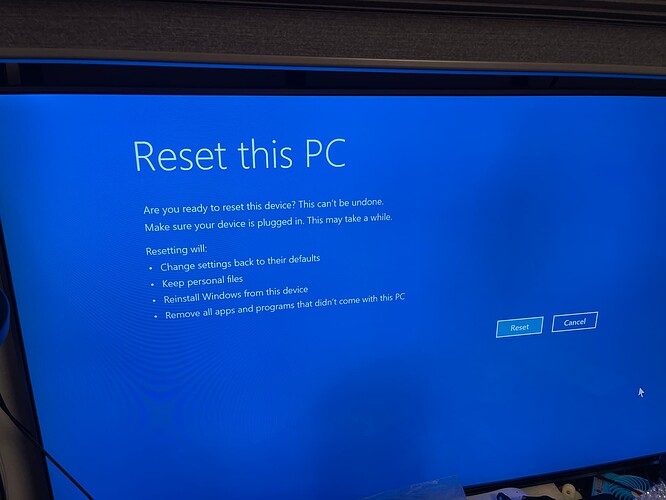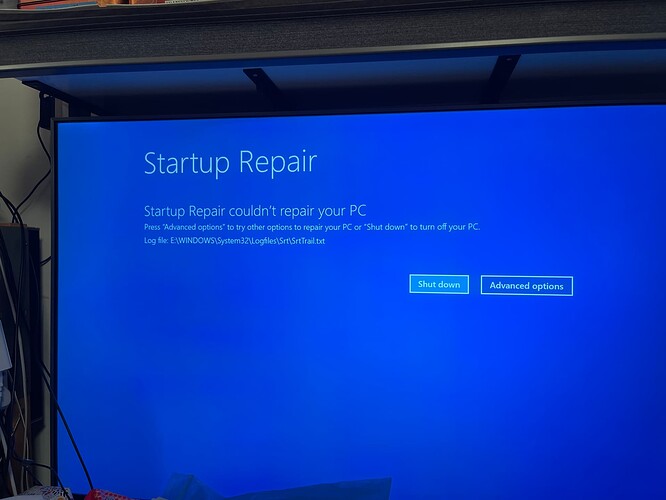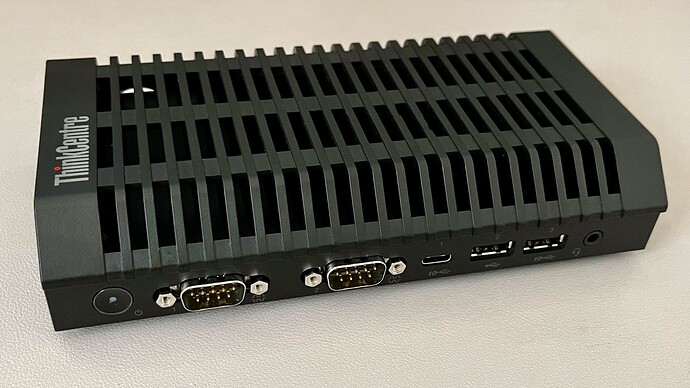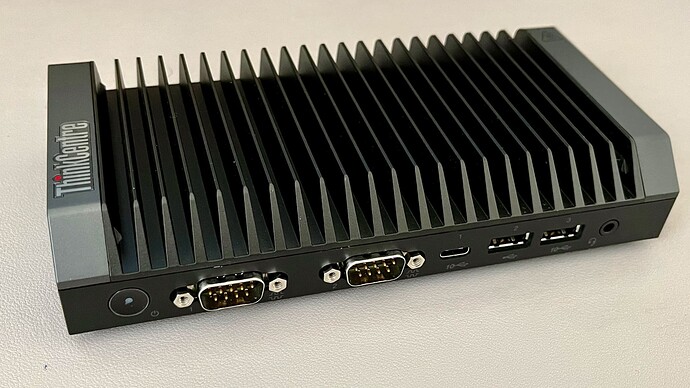Sorry, I’m a noob in Proxmox. I have some experience in Truenas Core. Thanks for the clarification. I’m going to try that virtual SATA drive in the VM.
Successfully running ROCK on NUC 11 Essential NUC11ATKC4 w/ Celeron N5105. Easy install, seems very fast and responsive with small library and limited DSP. Seems a good inexpensive “starter” ROCK, not officially supported but still within the NUC line.
Have someone tried to use rock on a laptop?
I have a old i7 with 16hb ram and 512gb SSD.
If there are no exotic devices driver wise it could work, but still wouldn’t be supported.
Don’t forget, you need two drives, one for the system and one for the music files.
Or if you don’t have a second internal drive, an USB drive or network share does the same.
I have a 4 tb external harddisk drive, not ssd.
Encountered one issue with my NUC 11 Essential: can’t get the NUC’s HDMI to output sound. Turned on HD Audio in BIOS, but I suspect that’s just for the onboard audio codec.
yes!
I run it on a old HB zook G2 I7 with 20GB ram en 256 SSD + 2TB HDD works perfectly
I did have to turn off turbo boost in bios, otherwise he laptop ran quite hot, with turbo boost disabled, its runs super cool.
you also have to fidle around with EUFI / Legacy settings and you need an usb keyboard
I thought the amd 5600g sounded special but the 7700x running Roon Rock is yet another level. Used a gigabyte aorus b650m aorus pro with 2x8 gb Kingston beast 6000mhz ram, 256gb m.2 and samsung 8tb SSD in a thermaltake v21 case with ‘rotated’ noctua passive cooling and replacement noctua 10" fan. Set cpu smt off to disable threads and eco mode 65watts. Used a jcat xe USB card in pcie slot 1 and USB c to ethernet for lan access. Teradak 600w linear power supply and plixir 2 amp 5v for the jcat. The roon library processing set to 6 core. Runs dsd512 upsampling. Was a bigger improvement than the Holo May dac!
Why do you ask for the inevitable abuse?
Now we wait for someone who uses an AMD Epyc 9454 dual socket system, to run ROCK on it.
192 cores and 384 threads could be barely enougth for it, but don’t forget to also put 12TB RAM in the system.
I have ROCK installed on an i7-9700 in an Asus H110T Thin-ITX motherboard with 16GB of RAM and a Samsung 970 EVO SSD. I was never able to get multi channel HDMI audio to work, though.
Rock on old laptop
i7-7500U @ 2.70GHz 2.90GHz
16gb ram 240ssd 2tb harddrive.
Windows 10 crashed irrecoverably with my main core on it…
Tired of all the windows OS issues, I decided to run ROCK up and I’m impressed with the speed now.
ASROCK i7-10700 32gb ram 128gb m.2 ssd Fanless HDPlex chassis with 19v LMPS and 400W HDPlex ATX power supply.
The latest updates to rock have resolved the amd Mobo 2.5g nic issues which are now supported and I no longer need the USB to Ethernet adapters. Rock can also be installed on uefi supported motherboards with legacy boot no longer a requirement. This should open up a whole new set of mock installs. Note to get multi channel HDMI to work I use cheap second hand nucs running windows and roon bridge. This device is also useful as an IR remote interface (eg Logitech harmony) which with windows keyboard settings supports remote commands such as next and previous tracks. I’m now looking for a workflow app that will enable the remote to change zones.
My non-working HDMI audio resolved itself with build 256, which also seems to have fixed a minor issue where video of the OS console (rendered thru HDMI to 4K TV) was shifted up and left by many pixels. No other issues yet on my not-officially-supported NUC 11 Essential and its puny Celeron CPU.
Been thinking for some time about setting up a dedicated system for my Roon core, instead of running Roon Server on my laptop. Some experience with fanless Raspberry Pi systems convinced me I wanted my core machine to be fanless as well. Silence is golden!
Lenovo makes a miniature fanless PC that’s intended for very lightweight work - e.g. powering a computer terminal or digital signage system - called “M75n iot nano”. If Roon sold a micro-Nucleus, I think it might look something like this: a simple black box about the size of a small paperback book, with metal heatsink fins all across the top. The ones running Windows were a bit pricy, even refurbished. But I found the ones running Lenovo’s proprietary locked-down thin-client “LetOS” operating system can be had for dirt cheap. I got one with an AMD Athlon 3050e CPU (about like an i3), 4GB of RAM and a 128GB SSD for $135 from a place called madepc.com. Specs are pretty much what Roon recommends for a NUC running ROCK with a small library. Even came with a wireless mouse and keyboard - cheap feeling but functional, and anyway only needed for the initial setup. N.B. - the video out is DisplayPort, so you’ll need an adapter if your monitor is HDMI. The PC itself feels heavy and solid, so it stays put.
Stock appearance - with the plastic heat shield installed. It stays cool to the touch. More USB ports, Ethernet jack, video out and power in are on the back.
I confess it was a bit tricky getting it to recognize the ROCK installation USB stick. Almost gave up. I knew it needed some BIOS settings to be changed, but how to get in to the BIOS? I’ll spare you the hour or so of Google work I did - you need to hold down F1 while it does a cold boot. Cold, as in “pull the power cord out”. If anyone’s interested, I can share the exact BIOS changes I made; but basically I first turned off a high-security setting prohibiting booting from USB, then moved USB up to the top of the boot drive order. After that, ROCK installed very easily following Roon’s directions for a NUC. I did have to go back into the BIOS settings afterwards, and move USB back down below the built-in SSD in the boot order.
Not sure if this thing has WiFi - I’m using an Ethernet cable as Roon recommends. Right now I’m using a USB stick for my data drive, but I’m getting an SSD for the empty secondary M.2 slot inside the M75. Just to keep things clean and simple. I’m also getting some dust plugs - available for cheap on Amazon - to cover up the unused ports on this thing, since I live in a very dusty environment. I didn’t go overboard with the SSD size, so this whole thing will be less than $200.
Appearance with the heat shield removed. It does feel a little bit warm to the touch after a while, but I think it looks much better without the plastic.
I realize this is un-supported, but I’m not expecting Roon (or Lenovo) to help me at all. If some future change in ROCK makes it stop working, I’m sure I could just install Ubuntu and run Roon Server instead of ROCK. Migrating to the new core, and transferring my license and data, worked just fine following Roon’s instructions. Daily use feels exactly the same as it did when the core was running on my laptop. I power down all office equipment at the end of the work day, and I’ve found this core comes alive in less than a minute when I turn everything back on in the morning.
I’m guessing most people on this forum are power users, looking for a high-octane system for their Roon core. Not me - I’ve got a small Loxjie stereo amp, a Pi running the @DrCWO rooExtend plugged into the amp’s USB input, and a set of small bookshelf speakers. That’s it. I have a fairly small library of FLAC files ripped from my old CDs or purchased from Qobuz: ~120 albums, ~1400 tracks. ~50 GB. I don’t have multiple zones, or do any signal processing. I just like to have some quiet music in my office, and I like the artist-discovery features in the Roon UI. For that scenario, this little machine works very well for me. Highly recommended!
Hey, thanks for the tip. I went to the website (madepc) and couldn’t find the computer anywhere on the site. Maybe you got the last one? Or maybe my shopping skills are lacking after the holiday rampage.
Thank you for your input regarding Roon Core. I like to also share my experience with a small and inexpensive box for the Roon Server.
For some years I used a Gigabyte BACE (also fanless), 8GB, Win10, 2TB SSD.
As I run it with Win10 I simply installed Roon Server on it. On the SSD I have two partitions, one small for Win10 the bigger one for the music library.
Runs nice even if DSP with Room correction, and XO (I run a fully active system) is in. So I think this box also might be a recommendation for a chap Roon Server Box.
The only drawback with this box is my big library with more than 60000 tracks. Powering the BACE it takes 10min until it can be used so I placed it in my cellar running all the time. Using it for some years now I more and more dislike the waiting time (10s) until I see the Roon Home screen after starting Roon GUI on my iPad. This is really the ONLY drawback. With anything else I was happy the last years and I am a power user ![]()
To improve the situation I installed Debian hoping I will get more performance but no win.
Finally yesterday I ordered a NUC7i7 and guess this will shorten the waiting time after starting Roon GUI.
What I learned is that for small libraries such a cheap box is absolutely sufficient even if you use DSP. For bigger libraries you should use a faster device.
Best DrCWO
On my Rock based NUC10I5 (16GB) it feels about 1 minute from restart that Roon is available (maybe a little longer) so much better, but never fast enough.
Yours might be even faster, My library is about 80k so not a massive difference really.
NUC10i5, beyond my budget but hopefully same as NUC7i7 16GB. The one I ordered has a super fast M.2 SSD. The complete box with 16GB and 500GB M.2 for 500€ isn‘t that bad ![]()
I will continue leaving it on all time so no issue here. But I hope for a better GUI performance with the i7 ![]()



